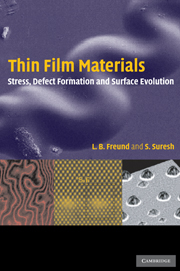Book contents
- Frontmatter
- Contents
- Preface
- 1 Introduction and Overview
- 2 Film stress and substrate curvature
- 3 Stress in anisotropic and patterned films
- 4 Delamination and fracture
- 5 Film buckling, bulging and peeling
- 6 Dislocation formation in epitaxial systems
- 7 Dislocation interactions and strain relaxation
- 8 Equilibrium and stability of surfaces
- 9 The role of stress in mass transport
- References
- Author index
- Subject index
6 - Dislocation formation in epitaxial systems
Published online by Cambridge University Press: 06 July 2010
- Frontmatter
- Contents
- Preface
- 1 Introduction and Overview
- 2 Film stress and substrate curvature
- 3 Stress in anisotropic and patterned films
- 4 Delamination and fracture
- 5 Film buckling, bulging and peeling
- 6 Dislocation formation in epitaxial systems
- 7 Dislocation interactions and strain relaxation
- 8 Equilibrium and stability of surfaces
- 9 The role of stress in mass transport
- References
- Author index
- Subject index
Summary
The generation of film stress as a natural consequence of epitaxial constraint arising from mismatch between the lattice parameters of a thin film and its substrate was discussed in Section 1.7, and elastic strain induced in layered epitaxial materials was analyzed in Section 3.4. The stress associated with the elastic strain acts as a driving force for formation and growth of structural defects. An image of dislocations that have formed at the interface between SiGe and Si in this way appears as Figure 1.16 and a second image of dislocations that have been formed at the interface between CdTe and GaAs appears as Figure 1.18. The presence of such misfit dislocations, in turn, can have a detrimental effect on the performance of strained layer material systems. Lattice strain in SiGe materials alters the electronic bandgap, a behavior that can be exploited to good advantage in some circumstances. Strain can also alter band edge alignment, thereby converting an indirect bandgap material into a direct bandgap material and rendering it a candidate material for optoelectronic applications. In cases in which lattice strain is induced to achieve some functional objectives, the formation of strain-relieving dislocations can be particularly deleterious as noted in Section 7.3.2. Even for cases in which it is not essential that the strain be maintained, the presence of dislocations can have an adverse effect on electronic performance of semiconductor materials, serving as easy diffusion paths for dopants or as recombination centers to diminish carrier density in devices (Mahajan 2000).
- Type
- Chapter
- Information
- Thin Film MaterialsStress, Defect Formation and Surface Evolution, pp. 387 - 463Publisher: Cambridge University PressPrint publication year: 2004

